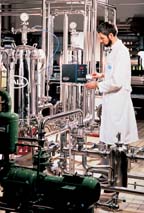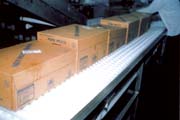

Part of the discussion revolves around the organic biocide triclosan. Triclosan is the active ingredient in Microban. According to a report published in a peer-reviewed journal of the Centers for Disease Control and Prevention, mutant strains of triclosan-resistant E. coli bacteria were easily isolated in lab tests. “The mutant required up to 100 times more triclosan (than wild E. coli) to show even minimal inhibition of fatty acid biosynthesis,” according to Stuart B. Levy of Boston’s Tufts University School of Medicine and a leading critic of excessive use of antimicrobials.
“Levy has tried to link antibiotics and biocides, but in fact they’re not linked,” insists Wayne Saffort, who heads R&D at Microban in Huntersville, NC. “With antibiotics, you start to see resistant organisms within four years. With triclosan, there have been no other reports of resistance in 30 years.” Saffort questions the validity of Levy’s testing methodology.
Levy is the director of the university’s Center for Adaptation Genetics and Drug Resistance. He authored, “The Antibiotic Paradox: How Misuse of Antibiotics Destroys their Curative Powers.” His work is at the heart of another controversy surrounding fluoroquinolone-resistant Campylobacter in chickens.
These mutated pathogens are linked to antimicrobials used to treat respiratory diseases in poultry. “Campylobacter in the intestinal tract can contaminate the carcass at slaughter and during processing,” the FDA’s Center for Veterinary Medicine (CVM) cautions in an industry guidance. Cross-contamination to otherwise healthy birds on farms and carcasses in chillers can occur, CVM’s David G. White says, further increasing the likelihood that the drug-resistant bacteria will be ingested by humans. To reduce the risk of antibiotic-resistant bacteria finding a home in people’s digestive tracts, CVM recommends a variety of “prudent use” practices, such as cleaning out litter in coops before a new flock is introduced, more temperate use of fluoroquinolones (vs. wholesale spraying of flocks) and the elimination of some previously approved livestock medications.
This last step is easier said than done. CVM recommended the withdrawal of approval for Bayer Corp.’s enrofloxican three years ago. Public hearings recently concluded, and an FDA decision on the matter isn’t expected until the end of the year, at the earliest, says White. In the meantime, he says, McDonald’s Corp. instructed its suppliers two years ago to stop treating chickens with enrofloxacin, along with all other fluoroquinolones. Domino’s Pizza requires suppliers to guarantee that their chickens are not subjected to nontherapeutic, routine feeding of eight classes of human antibiotics. Abbott Laboratories voluntarily withdrew an antibiotic similar to enrofloxacin.

The well-coated plant
Levy’s warning about organic biocides comes as a raft of antimicrobial coatings and additives for food plant surfaces and equipment are bursting onto the market. Besides a host of triclosan-based compounds, more than 40 different silver-based antimicrobials are available, as well as zinc- and copper-based remedies. In most applications, the antimicrobial is being incorporated in plastic parts and surfaces. It is added as a compound that is blended into the base resin during the polymerization process.While these antimicrobials are just beginning to penetrate the food industry, they already are the fabric of our lives—literally. Manufacturers of active sportswear are incorporating antimicrobials into clothing as odor-eaters, and makers of industrial floorcoverings are weaving antimicrobials into carpet. Procter & Gamble has invested heavy R&D dollars on antiviral and antibacterial additives for tissue paper. Metal ions and tricolosan are among the active ingredients.
Agion Technologies and Milliken Chemical are emerging as the major suppliers of nonorganic silver antimicrobials. Silver’s effectiveness against bacteria, viruses and mold has long been recognized. From a chemical engineering perspective, the challenge is devising a compound that releases sufficient amounts of silver ions to kill microbes at a rate that won’t dissipate effectiveness before the end of the equipment’s useful life.
Like Microban, Wakefield, Mass.-based Agion acts as a licensing and marketing authority. Its licensees include AK Steel, a Middletown, Ohio, mill that is developing the market for steel coated with Agion’s compound. The division’s greatest success to date has been in the medical and HVAC fields. Fabricators of heating and cooling ducts see potential for silver ions to prevent the spread of legionnaire’s disease.
Milliken Chemical’s silver antimicrobial is marketed as AlphaSan. Milliken both licenses AlphaSan’s use (it goes to market under the name Silveron on Westlake Plastics’ food-handling products) and uses it in its own manufacturing. AlphaSan is silver sodium hydrogen zirconium phosphate. The silver biocide is encapsulated in sodium phosphate crystals of about one micron. Milliken uses the agent in a line called Elastoguard, a compound which is embedded in rubber seals, gaskets, rubber paddles and other parts.
Elastoguard is the only silver-based antimicrobial for rubber compounds, according to Scott McDowell, business development manager at Milliken Coated Products’ White Stone, S.C., plant. He claims bacterial load reductions of more than 4 Logs (99.99 percent) have been achieved over 24 hours in lab tests.
Another AlphaSan virtue is its neutral effect on a base material’s color. Color fastness was a deciding factor in Ghislain Beauregard’s selection of AlphaSan as the antimicrobial element in his ceiling and wall panels. Beauregard heads Arcoplast Inc., a Chesterfield, Mo., fabricator of fiberglass composite panels for clean room applications, including pharmaceutical, beverage and dairy plants. “The first thing the USDA people want to see is bright-white surfaces that say cleanliness. Our panels are immaculately white,” he says.
“I can’t say it increased our business in the first few months, but once they understand the benefits, customers aren’t interested in eliminating it to reduce costs,” says Beauregard.
Panels were installed recently in a brine room at the Stockton (Ill.) Cheese plant. The lactic acid from cheese is highly corrosive, even to stainless steel surfaces, and the former Kraft cheese plant makes extensive use of Arcoplast’s ceiling and wall panels. “Temperature in a brine room is 34˚ F, and that plus the salt isn’t conducive to the growth of bacteria,” allows Plant Manager Chuck Loeher. Still, antimicrobials help inhibit any mold growth. Areas where raw milk is handled could see significant benefit from treated ceiling and wall panels.

Conveyor controversy
Given conveyors’ role in moving food in plants, antimicrobials would seem to be a natural safeguard against mold, mildew, viruses and bacteria. One of the first companies to recognize this was Globe International, a Buffalo, N.Y., firm, which applied for a patent eight years ago for a belt using Microban in the polymeric material. Globe now is part of Habasit, a Swiss corporation that bought Globe to acquire its conveyor patent. The belting is used extensively in Japanese food plants, a Habasit official says, though European and American manufacturers are still evaluating it.“The beauty of the system is that, as the belt braids, more of the Microban agent comes to the surface of the belt,” explains Miles Rothman, one of the belt’s inventors.
The active ingredient in Habasit’s fabric and plastic belts was changed from triclosan to another chemical, according to Harry Cardillo, former Globe president who now heads Habasit’s U.S. operations in Atlanta. He could not name the chemical, though he did say it’s EPA approved for direct food contact.
Triclosan-impregnated belting from Rexnord was tested last year by poultry processor Wayne Farms (Food Engineering, January 2003), and J.R. Simplot Co. began using the antimicrobial belting last year at two potato processing facilities (Food Engineering, October 2002). But Gary Larson, manager of technical support for hygienic industries at Intralox Inc., Harahan, La., maintains triclosan is ineffective against pseudomonas, a spoilage organism he maintains is “the most common type of bacteria in a plant.” He also is concerned about the antimicrobial-resistant bacteria reported by Tufts University’s Levy.
Larson says Intralox has been unable to demonstrate a consistent 1-Log reduction in bacterial loads with any antimicrobial coating, and the company has not been able to arrange independent challenge tests in plants where positive results have been reported. “I won’t say they just flat-out don’t work, but there doesn’t seem to be any consistency in the results,” he says.
Makers of antimicrobial coatings and additives argue that it is unrealistic and unfair to expect a specific log reduction from these systems, particularly on a conveyor belt that is in direct contact with a product for a short time. Antimicrobials can achieve up to 5-Log reductions over 24 hours, and that can be a major benefit for equipment and surfaces that are not sanitized as scrupulously or as frequently as needed to prevent bacterial colonization. Instead of a first line of defense, these systems should be regarded as support agents that contribute to a sanitary operating environment.
Same old sanitizers
To bolster its case for bacterial mutation, the Levy article cited a study in which seven percent of Listeria monocytogenes isolated from food and the environment were resistant to quaternary ammonium compounds, one of the fundamental groups of sanitizers used in processing facilities. To which plant sanitation experts would say, “No kidding.”Quaternary ammonia (quat) and chlorine-based compounds are the two essential arrows in every sanitarian’s quiver, notes Aramark ServiceMaster Technician Guy DeVicentis, a 30-year veteran of food-plant sanitation. Quat is particularly effective because of the protective biofilm it leaves on equipment, “but sometimes bacteria builds up a tolerance.” Alternating between quat and chlorine should resolve the resistance issue, “if the cleaning is there,” DeVicentis says.
“Bacteria’s got to have water,” adds Stockton Cheese’s Loeher. Sanitation systems that use little or no water are replacing traditional approaches that sometimes proved counterproductive. “We need to take a look at our practices and, instead of applying a band-aid, maybe prevent the cut from happening in the first place,” he suggests. “When all is said and done, maybe we should dry the equipment after washdowns and stop chlorinating the floors and spreading more bacteria than we kill.”
Foot foamers replaced chlorine foot baths at the plant when sanitarians realized the underside of the pans was a breeding ground for bacteria. “Chlorine degrades when it comes into contact with any kind of organic material,” points out Jonathan Kingsbury, food and beverage marketing manager at Ecolab Inc., which supplied the automatic door foaming system used at Stockton Cheese. The system lays down a foam blanket each time a worker or lift-truck tire breaks an infrared beam.
Chemical resistance is a moot point if chemicals aren’t used in the first place. One way to accomplish that and ensure the safety of liquids is with microfiltration and ultrafiltration technology. Happily for food processors, filtration systems that prevent bacteria, yeast and spoilage organisms from moving through processing are reaching a higher level of refinement.
“Any chemical you add to your product or your processing water changes the molecular signature of your product’s flavor,” notes Tom Wingfield, marketing vice president of Pall Corp., East Hills, N.Y. “A membrane filter gives you an absolute barrier and absolute control over your process.”
When assessing the threat posed by microbial life forms in their plants, food professionals need to be mindful that the enemy doesn’t have or need weapons of mass destruction. Their strength lies in numbers, and the best way to combat them is with multiple antimicrobial systems.
For more information:
Guy DeVicentis, Aramark Service Master, 636-357-3844
Jonathan Kingsbury, Ecolab Inc., 651-293-4126
Harry Cardillo, Habasit, 678-288-3456
Gary Larson, Intralox Inc., 504-733-1050
Scott E. McDowell, Milliken Chemical, 864-598-0107
Tom Wingfield, Pall Corp.516-484-5400, tom_wingfield@pall.com
Pamela Giddon, AgION Technologies Inc., 781-224-7100
Ed Case, AK Coatings, 866-571-6352
Wayne Swaffort, Microban International Inc., 704-875-0806

Sidebar: Natural antimicrobials take center stage
Every natural product from olive leaf extract to garlic is being promoted for its antimicrobial properties. Among the more promising are dried plums and prune-juice concentrates and activated lactoferrin.In research funded by the California Prune Board, Daniel Fung of Kansas State University achieved a 1-Log reduction of pathogens found in meat by adding three percent plum extract to inoculated ground beef. Unlike cinnamon and other spices he has studied for their antimicrobial properties, plum-based treatments are powerful antioxidants and help retain moisture.
Fung’s findings piqued interest in Japan, where several meat companies, including Keihan Meat Ltd., already were using prune juice concentrate as a humectant. Keihan, which produces a deep-fried, heat-and-eat hamburger coated with breadcrumbs, and three other firms are evaluating the juice’s performance as an antimicrobial. Two major U.S. processors also are conducting lab tests on prune concentrate as an antimicrobial and antioxidant.
This month, researcher A.S. Naidu expects to commercialize Activin, a carcass wash that relies on the milk protein lactoferrin. The lactoferrin is activated in a molecular-milieu optimization process that produces an iron-free structure. It destroys the fimbria that allow bacteria to attach themselves to meat surfaces, thereby preventing colonization. “This is a natural compound that has worked in mammals for thousands of years, so bacterial resistance is not anticipated,” according to Naidu.
Naidu developed the activated lactoferrin in the 1990s while at Cal Polytech’s Center for Antimicrobial Research in Pomona. In fact, he was the center, and when he left to secure FDA approval and form ALF Ventures LLC, the center ceased to exist. ALF is working with Farmland National Beef to bring the antimicrobial wash to market.